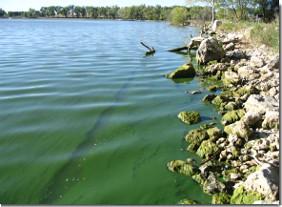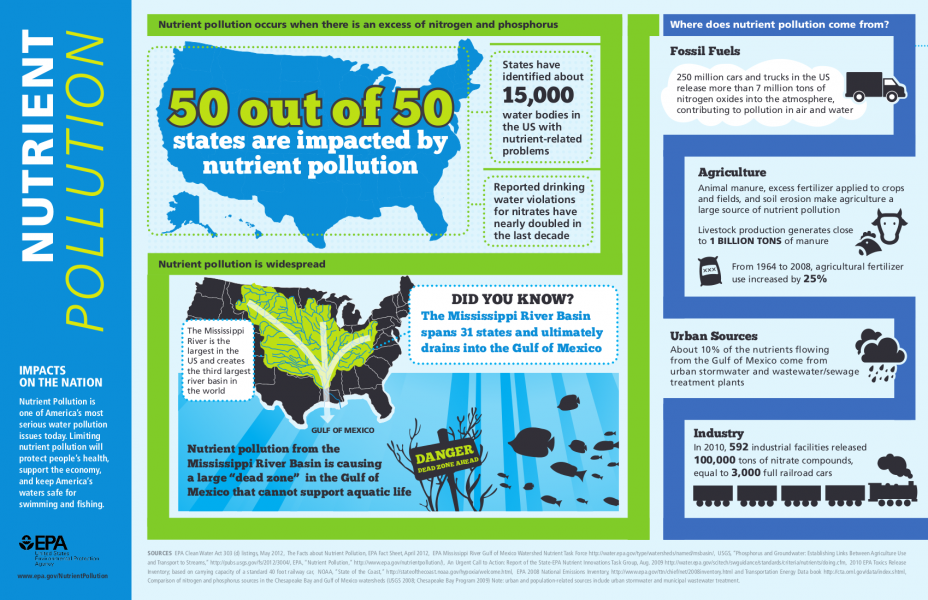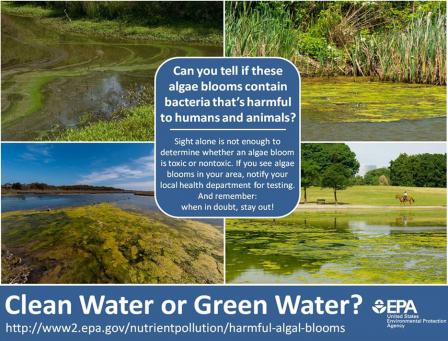Harmful Algal Blooms
Harmful algal blooms are a major environmental problem in all 50 states. Known as red tides, blue-green algae or cyanobacteria, harmful algal blooms have severe impacts on human health, aquatic ecosystems and the economy.
Algal blooms can be toxic. Keep people and pets away from water that is green, scummy or smells bad.
- Learn about harmful algal blooms
- See infographics, videos and other multimedia
- Find partner resources
Learn about harmful algal blooms

What are harmful algal blooms?
Harmful algal blooms are overgrowths of algae in water. Some produce dangerous toxins in fresh or marine water but even nontoxic blooms hurt the environment and local economies.
What are the effects of harmful algal blooms?
Harmful algal blooms can:
- Produce extremely dangerous toxins that can sicken or kill people and animals
- Create dead zones in the water
- Raise treatment costs for drinking water
- Hurt industries that depend on clean water
Learn more about these and other effects.
Did you know?
Climate change might lead to stronger and more frequent algal blooms.
Find out how.
What causes harmful algal blooms?
Harmful algal blooms need:
- Sunlight
- Slow-moving water
- Nutrients (nitrogen and phosphorus)
Nutrient pollution from human activities makes the problem worse, leading to more severe blooms that occur more often.
Learn where nutrient pollution comes from.
What you can do to help
Volunteer to monitor waterbodies for algal blooms
The following organizations help identify toxic algae outbreaks:
- National Oceanic and Atmospheric Administration Phytoplankton Monitoring Network Exit
- Association of Public Heatlh Laboratories Exit
- New York Citizens Statewide Lake Assessment Program Exit
- Kentucky Watershed Watch Exit
- Wisconsin Water Action Volunteers Exit
Report suspected algal blooms to your state
State departments of health or environment are the best sources for local information about harmful algal blooms.
Find your state's contact information.
Help prevent nutrient pollution
Simple actions around your home and yard can make a big difference
Multimedia
Free webinars
- October 30, 1pm ET:
New research on cyanotoxins and harmful algal blooms.
Blog
Keeping pets- and people- safe from toxic algae.
Two years ago, our family planned to take our Yellow Labrador puppy Fiona to Lake Needwood near our home in Rockville, Maryland for a swim. Read more...
Photos
Partner resources
The following links exit the site Exit
National resources
- North American Lake Management Society
- Resource Media
- NOAA Red Tide Forecast
- Woods Hole Oceanographic Institute
State resources
- Florida Fish and Wildlife Conservation Commission Red Tide Status
- Florida Mote Marine Laboratory Beach Conditions Report
- Lake Erie Harmful Algal Bloom Bulletin
- Nebraska Department of Environmental Quality Toxic Blue-Green Algae Monitoring
- Ohio EPA Harmful Algal Bloom Advisories
- Oklahoma Department of Environmental Quality
- Oregon Health Authority Algae Bloom Advisories
- Texas Parks and Wildlife Golden Algae Status Reports
- Texas Parks and Wildlife Brown Tide Status Reports
- Vermont Department of Health Blue Green Algae Tracking
- Vermont Watershed Management Division


